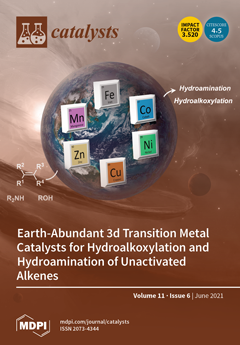Zeolite catalysts that could allow the efficient synthesis of
n-butene, such as 1-butene,
trans-2-butene, and
cis-2-butene, in the dimethyl ether (DME)-to-olefin (DTO) reaction were investigated using a fixed-bed flow reactor. The zeolites were characterized by N
2 adsorption and desorption,
[...] Read more.
Zeolite catalysts that could allow the efficient synthesis of
n-butene, such as 1-butene,
trans-2-butene, and
cis-2-butene, in the dimethyl ether (DME)-to-olefin (DTO) reaction were investigated using a fixed-bed flow reactor. The zeolites were characterized by N
2 adsorption and desorption, X-ray diffraction (XRD), thermogravimetry (TG), and NH
3 temperature-programmed desorption (NH
3-TPD). A screening of ten available zeolites indicated that the ferrierite zeolite with NH
4+ as the cation showed the highest
n-butene yield. The effect of the temperature of calcination as a pretreatment method on the catalytic performance was studied using three zeolites with suitable topologies. The calcination temperature significantly affected DME conversion and
n-butene yield. The ferrierite zeolite showed the highest
n-butene yield at a calcination temperature of 773 K. Multiple regression analysis was performed to determine the correlation between the six values obtained using N
2 adsorption/desorption and NH
3-TPD analyses, and the
n-butene yield. The contribution rate of the strong acid site alone as an explanatory variable was 69.9%; however, the addition of micropore volume was statistically appropriate, leading to an increase in the contribution rate to 76.1%. Insights into the mechanism of
n-butene synthesis in the DTO reaction were obtained using these parameters.
Full article





